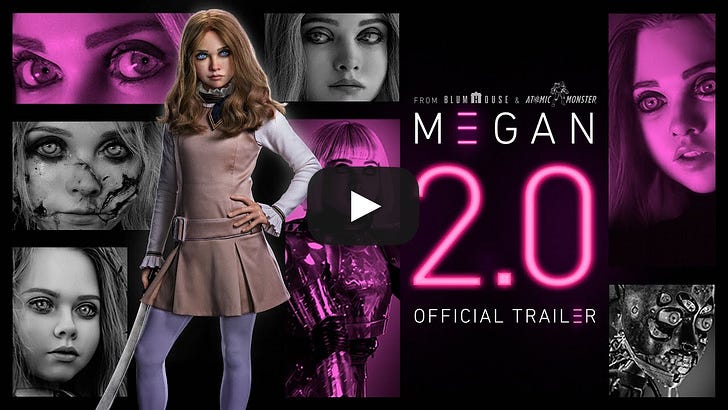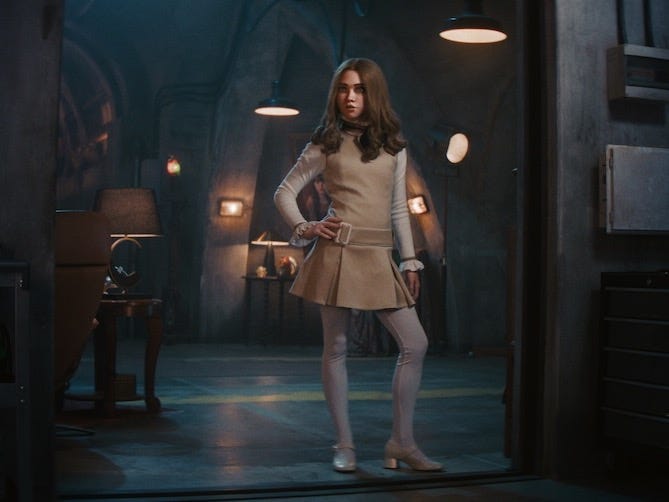|
 |
We hit 100,000 paid subscribers this week, but if you’re reading this, you’re not one of them. So come and join the fun and sign up now. As a member, you get to yell at me in the comments! And I have to read them! Think about how much fun that is. Think of all the power you’ll have over my mental well-being. I simply don’t see how you can turn it down. So join now!
–Sonny
Hollywood is the archetypal ‘victory has a hundred fathers, defeat is always an orphan’ sort of town. Whenever something does unexpectedly well you’ll see everyone—from the director to the producer to the stars to the projector company, if it was shot in IMAX—take a victory lap. When a movie bombs, though, the buck-passing can reach an almost comically fevered pitch. (See, for instance, how the knives came out when Elio flopped.)
Usually, a producer like Jason Blum would appear on Matt Belloni’s podcast to brag about a surprise hit like Five Nights at Freddy’s. And Blum has had lots of chances to do so, as he is almost inarguably the most successful and most important producer of the last twenty years, certainly on a return-on-investment basis: the man virtually cornered the market on cheap, profitable horror movies. From the Paranormal Activity series to The Purge films to the recent run of Halloween movies to surprise smash hits like the original M3gan to award-caliber prestige horror like Get Out and Whiplash,¹ Blum is the best there is at what he does.
Which is why it was so interesting to hear from Blum after the disastrous opening for Megan 2.0, which debuted to just $10 million, a decline of roughly two-thirds from the original’s opening weekend and a huge disappointment for a movie that, when it hit tracking, was looking pretty good. You should listen to his whole interview with Belloni, in which he runs through the litany of mistakes with more grace than I’d be likely to muster, taking the blame for, among other things, believing they could move from a January to a June release date, change the genre from horror to action-adventure without losing the original audience, and pull a T2 by transforming the villain into the hero. Audiences clearly weren’t interested in any of that.
Blum is very careful not to trash the distributor, Universal, and I’m sure what I’m about to say here isn’t entirely their fault. But the marketing campaign for M3gan 2.0 was kind of disastrous. Part of it was the belief that they could manufacture virality, playing off the clips of the dancing robot from the first film’s trailer that had intrigued bored January audiences enough into making the film a shock hit.
The biggest problem, though, was the film’s trailer.

Look, I go to a lot of movies. Since this trailer debuted two months ago, I have seen it in front of, conservatively, 85 percent of the movies I’ve seen. I’ve probably watched it a dozen times. And every time I watched it, I grew a little more annoyed with it. The tone of the thing is just grating, from the sassy robot to the jangly chords of Britney Spears’s teen-pop masterpiece “Oops!...I Did It Again” to the tween sneer of M3gan herself when she’s put in the “plastic Teletubby” for safekeeping. The most aggravating element of all: the grown man with a beard in a M3gan-style wig leering into the camera while squealing “I don’t care if she did kill four people, she’s a smokin’-hot warrior princess.”
“Ick,” as M3gan might say.
Every time I saw the trailer, I became approximately 10 percent less interested in seeing the movie, and it looks like I wasn’t alone: tracking dropped dramatically after its debut. What had looked like a $45 million opening wound up at just $10 million. Yes, yes: Tracking is not an exact science. I simply find it hard to believe that I was alone in finding this omnipresent-in-theaters piece of advertising to be incredibly off-putting.
The lesson, as always: trailers matter!
Jurassic World Rebirth review
THE FIRST THREE JURASSIC PARK FILMS—particularly the first two Steven Spielberg-helmed entries—are defined by a sense of awe, of childlike wonder. This comes through visually, of course: the defining image of the first film is Dr. Alan Grant (Sam Neill) fumbling with his glasses, gasping, unsure what he’s seeing, unable to believe it. He grabs Dr. Ellie Sattler’s (Laura Dern) head, physically turning her attention from the plant she’s looking at to the enormous figure in the middle distance, a long-extinct figure mooing. When he’s told there’s a T. rex on the grounds, Alan can’t breathe, he puts his hands on his knees, he’s stunned.
And yes, this is all wrapped up in money—“We’re gonna make a fortune with this place” is how the “blood-sucking lawyer” expresses his sense of awe—but it wasn’t just about money. “This park was not built to cater only for the super-rich. Everyone in the world has the right to enjoy these animals,” according to park founder John Hammond (Richard Attenborough). Of course, that sense of awe curdles into terror as the film progresses, culminating in a giant T. rex eye peering through a window, its pupil dilating when hit with a flashlight beam. But still, even at the end, as the banner pronouncing dinosaurs ruling the Earth came fluttering down and the T. rex roared triumphantly over her defeated raptor foes, the vibe was one of astonishment, even reverence.
The prevailing vibe in the Jurassic World series of films that kicked off a decade ago is different. Awe is out. These are movies, ultimately, about the boredom that would inevitably set in once dinosaurs returned from extinction. You see this in the initial entry’s creation of the Indominus rex, a hybrid dinosaur that combines the size of a T. rex with the hunting skills of a raptor and other various snips and strands of DNA. Why make this mutant monster? To keep ticket sales up at the Jurassic World theme park. There are only so many times you can show people a pterodactyl or a triceratops. The people are always looking for something new, something exciting. Otherwise they get … bored.
